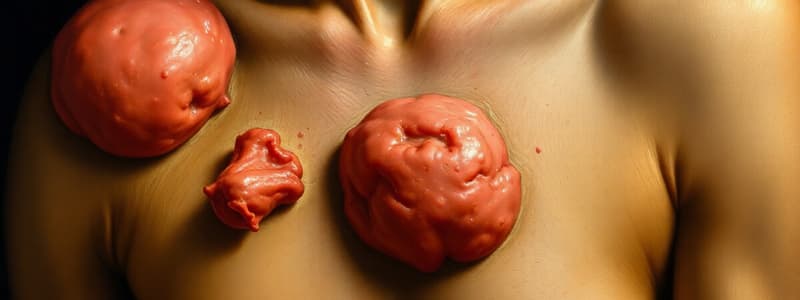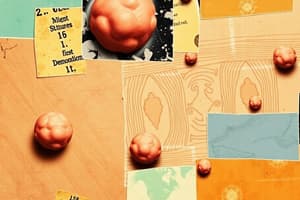Podcast
Questions and Answers
What health condition can potentially arise due to the factors mentioned?
What health condition can potentially arise due to the factors mentioned?
- Melanoma
- Basal cell carcinoma
- Eczema
- SCC (correct)
What precaution is suggested regarding the change in risk for developing SCC?
What precaution is suggested regarding the change in risk for developing SCC?
- Caution is advised as changes are possible. (correct)
- Risk remains constant regardless of exposure.
- It may not change at all.
- It is certainly going to change.
Where are acanthosis nigricans lesions typically found?
Where are acanthosis nigricans lesions typically found?
- On the face
- In the flexural areas
- On the trunk and extremities (correct)
- On the hands and feet
Which of the following areas is not commonly affected by acanthosis nigricans lesions?
Which of the following areas is not commonly affected by acanthosis nigricans lesions?
Besides UV light, which of the following is also mentioned as a contributing factor to SCC?
Besides UV light, which of the following is also mentioned as a contributing factor to SCC?
What does the statement about people with brown color imply?
What does the statement about people with brown color imply?
What is the primary characteristic of acanthosis nigricans lesions?
What is the primary characteristic of acanthosis nigricans lesions?
Which of the following substances could potentially influence the risk of developing SCC?
Which of the following substances could potentially influence the risk of developing SCC?
Which statement about acanthosis nigricans is true?
Which statement about acanthosis nigricans is true?
What is a false impression about acanthosis nigricans?
What is a false impression about acanthosis nigricans?
What type of environmental factors can induce similar lesions?
What type of environmental factors can induce similar lesions?
Which of the following is NOT mentioned as a factor that may induce similar lesions?
Which of the following is NOT mentioned as a factor that may induce similar lesions?
If one were to categorize the factors that can induce similar lesions, which category would they fall under?
If one were to categorize the factors that can induce similar lesions, which category would they fall under?
What type of radiation is specifically mentioned as a risk factor for inducing lesions?
What type of radiation is specifically mentioned as a risk factor for inducing lesions?
In terms of health impact, what do industrial hydrocarbons and arsenicals have in common?
In terms of health impact, what do industrial hydrocarbons and arsenicals have in common?
What does the term 'pre-malignant' refer to in the context of conditions like acanthotic keratosis (AK)?
What does the term 'pre-malignant' refer to in the context of conditions like acanthotic keratosis (AK)?
What occurs during the development of a non-benign condition as described?
What occurs during the development of a non-benign condition as described?
Why is it crucial not to disregard conditions like acanthotic keratosis after diagnosis?
Why is it crucial not to disregard conditions like acanthotic keratosis after diagnosis?
Which statement about the characteristic behavior of non-benign lesions is true?
Which statement about the characteristic behavior of non-benign lesions is true?
What is a common misconception about acanthotic keratosis?
What is a common misconception about acanthotic keratosis?
What characteristic of dysplastic nevi is highlighted in the content?
What characteristic of dysplastic nevi is highlighted in the content?
How does the content describe the progression of dysplastic nevi?
How does the content describe the progression of dysplastic nevi?
What does the content imply about actinic keratosis (AK)?
What does the content imply about actinic keratosis (AK)?
What term is used to describe the abnormal changes in cells mentioned in the content?
What term is used to describe the abnormal changes in cells mentioned in the content?
Which of the following statements about dysplastic nevi is true?
Which of the following statements about dysplastic nevi is true?
What condition is associated with a sharp rise in the incidence of BCC?
What condition is associated with a sharp rise in the incidence of BCC?
Which inherited condition is linked to defects in DNA repair and a higher risk of BCC?
Which inherited condition is linked to defects in DNA repair and a higher risk of BCC?
What characteristic may some tumors that contain melanin share?
What characteristic may some tumors that contain melanin share?
Which of the following factors does NOT contribute to the incidence of BCC?
Which of the following factors does NOT contribute to the incidence of BCC?
How does immunosuppression impact the risk of BCC?
How does immunosuppression impact the risk of BCC?
Flashcards
Acanthosis Nigricans Lesions Location
Acanthosis Nigricans Lesions Location
Acanthosis nigricans lesions are most commonly found on the trunk and extremities without involvement of flexural areas.
What is Acanthosis Nigricans?
What is Acanthosis Nigricans?
Acanthosis nigricans is a skin condition that causes dark, velvety patches of skin, most commonly on the neck, armpits, and groin.
What are Flexural Areas?
What are Flexural Areas?
Flexural areas are body folds, like the armpits, groin, and elbows.
Acanthosis Nigricans and Health
Acanthosis Nigricans and Health
Signup and view all the flashcards
What is Morphology?
What is Morphology?
Signup and view all the flashcards
Radiation Lesions
Radiation Lesions
Signup and view all the flashcards
Industrial Chemicals and Radiation Damage
Industrial Chemicals and Radiation Damage
Signup and view all the flashcards
Hydrocarbons
Hydrocarbons
Signup and view all the flashcards
Arsenicals
Arsenicals
Signup and view all the flashcards
Ionizing Radiation
Ionizing Radiation
Signup and view all the flashcards
UV light and SCC
UV light and SCC
Signup and view all the flashcards
Risk of SCC
Risk of SCC
Signup and view all the flashcards
Hydrocarbons and arsenicals
Hydrocarbons and arsenicals
Signup and view all the flashcards
Dysplasia
Dysplasia
Signup and view all the flashcards
Dysplastic Nevus
Dysplastic Nevus
Signup and view all the flashcards
Actinic Keratosis (AK)
Actinic Keratosis (AK)
Signup and view all the flashcards
Gradual Dysplasia
Gradual Dysplasia
Signup and view all the flashcards
Stable Dysplasia
Stable Dysplasia
Signup and view all the flashcards
Proliferating lesion
Proliferating lesion
Signup and view all the flashcards
Acanthosis Keratosis (AK)
Acanthosis Keratosis (AK)
Signup and view all the flashcards
Treating AK
Treating AK
Signup and view all the flashcards
Monitoring Proliferating Lesions
Monitoring Proliferating Lesions
Signup and view all the flashcards
BCC and Immunosuppression
BCC and Immunosuppression
Signup and view all the flashcards
Melanin in BCC
Melanin in BCC
Signup and view all the flashcards
Xeroderma Pigmentosum and BCC
Xeroderma Pigmentosum and BCC
Signup and view all the flashcards
What is Immunosuppression?
What is Immunosuppression?
Signup and view all the flashcards
DNA Repair and Cancer
DNA Repair and Cancer
Signup and view all the flashcards
Study Notes
Skin Tumors
- Skin tumors are categorized as benign, premalignant, and malignant epithelial tumors.
- Benign tumors are typically biologically insignificant but may cause discomfort.
- Premalignant lesions are a precursor to malignancy.
- Malignant tumors have the potential for aggressive growth and metastasis.
Benign Epithelial Lesions
- Seborrheic Keratoses, Fibroepithelial polyps, Acanthosis Nigricans, and Actinic keratosis are examples of benign epithelial tumors.
- Actinic keratosis is a premalignant lesion.
- Seborrheic keratoses are commonly found on the body.
- Fibroepithelial polyps are often flesh-colored, bag-like tumors.
- Acanthosis nigricans is a skin thickening with darkening.
Pathogenesis
- Mutations in the fibroblast growth factor receptor-3 (FGFR3) gene can lead to excessive growth.
- Tumors can be part of a paraneoplastic syndrome.
- The mutation of the PTCH gene can lead to basal cell carcinoma.
Morphology
- Histology reveals characteristics like keratin production, invaginations, or hyperplasia.
- Benign epithelial lesions often have small cells, brown pigment, and hyperkeratosis.
- Actinic keratosis exhibits roughness and a sandpaper-like texture.
- Fibroepithelial polyps are characterized by a stalk with a squamous epithelium covering.
- Morphology of squamous cell carcinoma features include highly anaplastic cells, keratinization, and possible ulceration.
- Keratoacanthomas are cup-shaped tumors with central keratin debris; they have a rapid growth phase followed by spontaneous regression.
Morphology of Basal Cell Carcinoma
- Histological features resemble normal basal cells.
- Two common patterns are multifocal (radial) and nodular (vertical).
- Basal cells often have a palisading appearance.
Premalignant Epidermal Tumors
- Actinic keratoses are precursor lesions for squamous cell carcinoma.
- The cells slowly and gradually become dysplastic.
- Exposure to ultraviolet light, industrial hydrocarbons, and arsenicals are factors that can induce similar lesions.
Treatment and Prognosis
- Actinic keratoses often regress or remain stable.
- Treatment options include gentle curettage, freezing, or topical chemotherapeutic agents.
- Keratoacanthomas spontaneously regress, but are not considered benign.
- Basal cell carcinomas are locally malignant but rarely metastasize.
Checkpoint Questions
- Provided information for the checkpoint questions are covered.
Studying That Suits You
Use AI to generate personalized quizzes and flashcards to suit your learning preferences.




